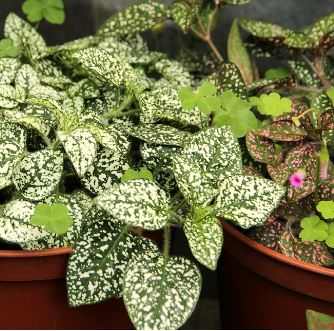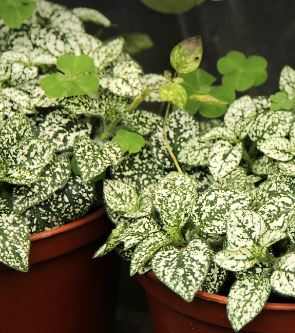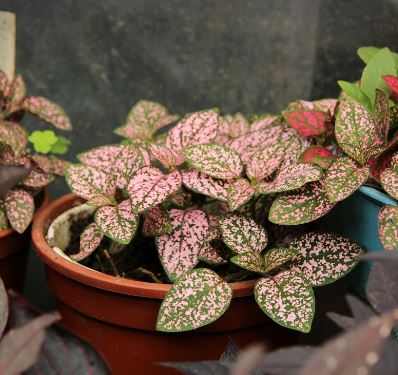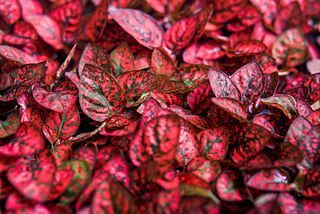Polka dot plants (Hypoestes phyllostachya) are delightful additions to gardens, known for their vibrant foliage and distinctive patterns. Whether you’re considering cultivating them indoors or outdoors, understanding the nuances of their care is crucial for their optimal growth.
Polka dot plants thrive both indoors and outdoors, with adaptable care strategies. Choose indoor cultivation for controlled conditions, and move outdoors in USDA zones 10 and 11. Prune for desired height, maintain well-draining soil, and watch for pests. Ensure vibrant coloration through sunlight, fertilizer, and pH adjustments.
Indoor or Outdoor: Choosing the Right Environment
Can polka dot plants thrive both indoors and outdoors?
Polka dot plants showcase adaptability to both indoor and outdoor environments. However, the decision between the two depends on various factors, including your local climate and the specific needs of the plant.
Indoor cultivation offers control over the growing conditions, making it ideal for regions with harsh weather. Polka dot plants can be grown as houseplants, adding a touch of color to your interior spaces. Consider placing them near windows to ensure they receive adequate sunlight.
Understanding USDA Zones for Outdoor Growth
Outdoor cultivation, on the other hand, is suitable for regions within USDA growing zones 10 and 11. In these zones, the plants can thrive in the natural outdoor environment. It’s essential to recognize your USDA zone to determine whether your location is conducive to polka dot plant growth.
Polka Dot Plant Outdoor Care: Nurturing in the Open
What are the key considerations for outdoor care?
Outdoor care for polka dot plants involves attention to temperature, frost, and overall environmental conditions. These factors play a crucial role in the plant’s health and longevity in an outdoor setting.
Temperature Requirements for Outdoor Success
Polka dot plants can survive temperatures as low as 50°F, but for optimal growth, temperatures should reach at least 60°F. It’s important to monitor the local climate and ensure that frosty conditions are avoided, as they can negatively impact the plant’s well-being.
Annual vs. Perennial Considerations
In colder climates, where temperatures may drop significantly, it’s advisable to grow polka dot plants as annuals or in containers that can be brought indoors during the fall. This protective measure helps preserve the plant and ensures its survival during unfavorable weather conditions.
Polka Dot Plant Growing Tall: Managing Height Effectively
What factors contribute to polka dot plants growing tall?
The height of polka dot plants can be influenced by various factors, including genetics, environmental conditions, and care practices. Understanding these factors is crucial for managing the plant’s height effectively.
Pruning Techniques for Desired Height
To control the height of your polka dot plant, consider regular pruning. Prune the plant’s tips to encourage bushier growth and prevent it from becoming too leggy. Additionally, removing any yellow or damaged leaves promotes overall plant health and appearance.
Managing Growth in Container Plants
If you’re growing polka dot plants in containers, the size of the container can impact their growth. Choose a container that accommodates the plant’s size and provides ample space for root development. Container plants may also benefit from occasional repotting to refresh the soil and stimulate growth.
Polka Dot Plant Care: Nurturing the Foliage
What are the essential care practices for polka dot plants?
Proper care for polka dot plants involves addressing their specific needs regarding soil, sunlight, and protection against pests and diseases.
Soil Requirements for Thriving Plants
Polka dot plants thrive in well-draining soil with a slightly acidic to neutral pH. A mix of potting soil with added organic matter provides an ideal growing medium. Ensure the soil remains consistently moist but not waterlogged to support healthy root development.
Fertilization Needs for Vibrant Foliage
Fertilize your polka dot plants during the growing season with a balanced, water-soluble fertilizer. Follow the manufacturer’s instructions for application rates, as over-fertilization can lead to adverse effects. This practice enhances foliage coloration and overall plant vigor.
Common Pests and Diseases: A Preventive Approach
Keep a vigilant eye for common pests like spider mites and aphids, which can affect polka dot plants. Regularly inspect the foliage for any signs of infestation and address the issue promptly. Additionally, practicing good hygiene by removing dead leaves and debris reduces the risk of diseases.
Polka Dot Plant Watering: Hydration Matters
How should I approach watering my polka dot plants?
Watering is a critical aspect of polka dot plant care, and finding the right balance ensures the plant’s health and longevity.
Watering Frequency for Optimal Moisture Levels
Polka dot plants prefer consistently moist soil. Water the plants when the top inch of soil feels dry to the touch. Adjust the frequency based on environmental conditions, with more frequent watering during hot and dry periods and less during cooler weather.
Signs of Underwatering and Overwatering
Pay attention to your plant’s leaves for signs of both underwatering and overwatering. Wilting and yellowing may indicate underwatering, while yellowing leaves and root rot may signal overwatering. Adjust your watering routine accordingly to address these issues.
Importance of Adequate Drainage
To prevent waterlogged soil, ensure that your planting containers have adequate drainage holes. Well-draining soil helps maintain the right moisture levels and prevents root rot, a common issue in polka dot plants.
Polka Dot Plant: Annual or Perennial?
What determines whether a polka dot plant is an annual or perennial?
Understanding the life cycle of polka dot plants provides insights into their longevity and growth patterns.
Factors Affecting Perennial Characteristics
While polka dot plants are typically grown as annuals in colder climates, their perennial nature becomes more apparent in warmer zones. Factors such as milder winters and consistent temperatures contribute to their ability to survive and regrow year after year.
Benefits of Growing as an Annual
Growing polka dot plants as annuals offers the advantage of starting fresh each growing season. This allows for experimentation with different varieties and ensures a constant display of vibrant foliage without concerns about winter dormancy.
Long-term Care Considerations
For those intending to grow polka dot plants as perennials, providing consistent care throughout the year is essential. Monitor winter conditions, protect the plants from frost, and ensure they receive adequate sunlight even during the colder months.
Polka Dot Plant Cultivars: Exploring Varieties
What are some popular cultivars of polka dot plants, and how do they differ?
Polka dot plants come in various cultivars, each with its unique characteristics, colors, and growth patterns.
Carmina: Bright Red Splotches
Carmina is a captivating cultivar known for its striking bright red splotches on the leaves. This variety adds a bold and vibrant touch to garden beds and containers, making it a favorite among garden enthusiasts.
Confetti: Smaller, Vigorous Growth
Confetti is a smaller and more vigorous growing cultivar, making it an excellent choice for those with limited space. Its compact nature doesn’t compromise on the plant’s visual appeal, as it retains the iconic polka dot patterns.
Pink Brocade: Mottled Pink Spots
Pink Brocade is celebrated for its mottled pink spots that create an elegant and delicate appearance. This cultivar adds a touch of femininity to gardens and is often chosen for its soft and sophisticated coloration.
Pink Dot: Distinctive Pink Spots
True to its name, Pink Dot features distinctive pink spots that stand out against the green foliage. This variety is prized for its eye-catching aesthetics and is a popular choice for those seeking a playful and charming addition to their gardens.
Hippo: Larger Leaves, Vigorous Growth
Hippo is distinguished by its larger leaves and more vigorous growth compared to other cultivars. This variety makes a bold statement in garden landscapes, offering a robust and dynamic presence.
Moving Container Plants Outdoors: Transitioning with Care
How can I successfully move my container plants outdoors?
Transitioning container plants outdoors requires careful planning and consideration to ensure a smooth adjustment for the polka dot plants.
Timing for Spring Transition
In the spring, after the last frost has passed, it’s an opportune time to move container plants outdoors. Gradually acclimate the plants by exposing them to outdoor conditions for increasing durations each day.
Gradual Adjustment to Outdoor Conditions
Abruptly moving plants from indoor to outdoor environments can shock them. Gradually expose them to outdoor conditions by starting with a few hours of sunlight and then increasing the duration over the course of a week.
Preparing Container Plants for Outdoor Growth
Before moving your container plants outdoors, inspect them for pests or diseases. Remove any dead or damaged foliage, and consider repotting if the roots have outgrown the container. This preparation sets the stage for healthy outdoor growth.
Outdoor Watering Practices: Sustaining Plant Health
What are the best practices for watering polka dot plants outdoors?
Outdoor watering practices play a crucial role in sustaining the health and vitality of polka dot plants. Establishing a routine that aligns with the plant’s needs and environmental conditions is key.
Morning and Evening Watering Routine
In outdoor settings, adopt a morning and evening watering routine. Watering in the morning allows the plant to absorb moisture before the heat of the day, while evening watering helps hydrate the plant after a day of sun exposure.
Adjusting Watering Frequency Based on Weather
Be responsive to changes in weather conditions. During hot and dry periods, increase the frequency of watering to prevent soil from drying out. Conversely, reduce watering during cooler and rainy periods to avoid overhydration.
Ensuring Proper Hydration in Outdoor Settings
Monitor the soil moisture consistently to ensure proper hydration. The top inch of soil should be kept consistently moist, providing the plant with the necessary water for healthy growth. Adjust watering practices as needed to maintain optimal moisture levels.
Providing Humidity for Outdoor Growth: Natural and Supplemental Approaches
How can I ensure that my outdoor polka dot plants receive adequate humidity?
Polka dot plants thrive in humid conditions, and providing sufficient humidity is crucial for their outdoor growth.
Natural Humidity in Outdoor Environments
Outdoor environments often have higher humidity levels compared to indoor spaces. Capitalize on this natural humidity by strategically placing your polka dot plants in areas with some shade, especially during the hottest parts of the day.
Supplemental Humidity Techniques
In regions with drier climates, consider implementing supplemental humidity techniques. Grouping plants together can create a microclimate with increased humidity. Additionally, misting the plants regularly or placing trays of water nearby can enhance the humidity around them.
Impact of Humidity on Plant Health
Humidity plays a significant role in the overall health of polka dot plants. Adequate humidity levels contribute to vibrant foliage, prevent leaf browning, and reduce the risk of stress-related issues. Monitoring humidity is particularly crucial during dry spells or in arid regions.
Shading Indoor Plants in Summer: Protecting from Intense Sunlight
How can I protect my indoor polka dot plants from intense summer sunlight?
As the seasons change, it’s important to adapt the care routine for indoor polka dot plants to shield them from the potentially harmful effects of intense sunlight.
Understanding Sun Exposure Changes
As summer approaches, the angle of the sun changes, leading to variations in sunlight exposure. Monitor how sunlight enters your indoor space and identify areas where your polka dot plants may receive more intense sunlight.
Identifying Signs of Sunburn
Polka dot plants are sensitive to direct sunlight, and prolonged exposure can result in sunburn. Signs of sunburn include brown or scorched patches on the leaves. If you notice these signs, consider relocating your plants to a spot with filtered or indirect sunlight.
Creating Ideal Conditions for Indoor Growth
Adjust the placement of your indoor polka dot plants to provide them with the ideal growing conditions. Consider placing them near windows with sheer curtains or in spots where they receive dappled sunlight. This helps mimic the conditions they would experience in their natural habitat.
Importance of Adequate Air Circulation
In addition to shading, ensure proper air circulation around your indoor plants. Stagnant air can contribute to heat buildup and may exacerbate the effects of intense sunlight. Use fans or open windows to promote a healthy airflow environment.
Frequently Asked Questions (FAQs)
How often should I water my outdoor polka dot plants?
Watering Frequency for Outdoor Success
Outdoor polka dot plants benefit from consistent moisture. Water them when the top inch of soil feels dry to the touch. During hotter periods, consider watering in the morning and evening to maintain optimal hydration levels.
Can polka dot plants survive cold temperatures?
Temperature Requirements for Outdoor Success
While polka dot plants can survive temperatures as low as 50°F, optimal growth occurs when temperatures reach at least 60°F. In colder climates, growing them as annuals or in containers that can be brought indoors during winter is recommended.
What are the signs of overwatering?
Signs of Underwatering and Overwatering
Overwatering can lead to yellowing leaves and root rot. If you observe these signs, adjust your watering routine by allowing the soil to dry slightly between waterings and ensuring proper drainage.
Should I bring my outdoor polka dot plants indoors during winter?
Annual vs. Perennial Considerations
In colder climates, it’s advisable to bring outdoor polka dot plants indoors during winter or treat them as annuals. This protects the plants from frost and ensures their survival for the next growing season.
How can I prevent my polka dot plant from growing too tall?
Pruning Techniques for Desired Height
To prevent polka dot plants from growing too tall, engage in regular pruning. Trim the tips to encourage bushier growth, and remove any yellow or damaged leaves. This helps maintain an aesthetically pleasing and well-proportioned plant.
Are there any specific soil requirements for polka dot plants?
Soil Requirements for Thriving Plants
Polka dot plants thrive in well-draining soil with a slightly acidic to neutral pH. Utilize a mix of potting soil with added organic matter to create an optimal growing medium. Consistently moist but not waterlogged soil is ideal.
What pests commonly affect polka dot plants?
Common Pests and Diseases: A Preventive Approach
Polka dot plants are susceptible to pests such as spider mites and aphids. Regularly inspect the foliage for signs of infestation, and address the issue promptly. Practicing good hygiene by removing debris helps prevent diseases.
Can I grow polka dot plants in containers throughout the year?
Moving Container Plants Outdoors: Transitioning with Care
Growing polka dot plants in containers allows flexibility. Move them outdoors in spring after the last frost, gradually acclimating them. Container plants can be brought indoors during winter or unfavorable conditions.
How do I promote vibrant coloration in my polka dot plant
Promoting vibrant coloration in your polka dot plant involves providing the right nutrients. Fertilize your plant during the growing season with a balanced, water-soluble fertilizer. The additional nutrients enhance the intensity of the colors and contribute to overall foliage health.
Sunlight Exposure for Color Enhancement
Adequate sunlight is crucial for vibrant coloration in polka dot plants. Ensure your plant receives bright, indirect light for a significant portion of the day. While they can tolerate partial shade, exposure to enough sunlight is key to unlocking their full color potential.
Adjusting pH Levels for Color Enhancement
The pH level of the soil can impact the coloration of your polka dot plant. Aim for a slightly acidic to neutral pH range. You can test the soil using a pH testing kit and make adjustments as needed with soil amendments, ensuring an environment conducive to vibrant hues.
Monitoring and Addressing Stress Factors
Stress can impact the coloration of polka dot plants negatively. Ensure the plant is not subjected to extremes in temperature, overwatering, or underwatering. Addressing stress factors promptly helps maintain the vibrancy of the foliage.
Consideration of Cultivar Characteristics
Different cultivars exhibit varying color patterns and intensities. Choose cultivars known for their vibrant coloration if this is a priority for your garden. Understanding the specific characteristics of each cultivar allows you to select plants that align with your aesthetic preferences.
Conclusion: Nurturing the Beauty of Polka Dot Plants
In conclusion, growing and caring for polka dot plants involves a careful balance of environmental considerations, attentive care practices, and an understanding of the unique characteristics of different cultivars. Whether you choose to cultivate them indoors or outdoors, providing optimal conditions and addressing their specific needs ensures a vibrant and visually appealing display.
By following the guidelines outlined in this comprehensive guide, you can embark on a journey of successful polka dot plant cultivation. From understanding the nuances of indoor and outdoor care to managing height, addressing common pests, and promoting vibrant coloration, your polka dot plants are poised for a flourishing and eye-catching presence in your garden or indoor space.
Experiment with different cultivars, adapt your care routine to seasonal changes, and enjoy the dynamic beauty that polka dot plants bring to your gardening experience. Remember, the key to success lies in observation, responsiveness to the plant’s needs, and a genuine passion for nurturing these charming and visually striking botanical wonders. Happy gardening!





